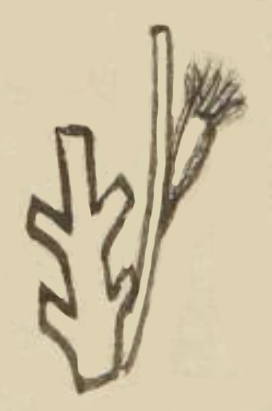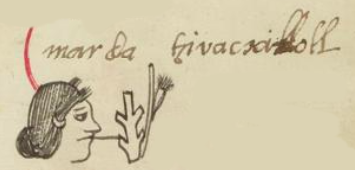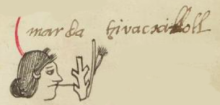Tzihuacxilotl (MH908r)
This black-line drawing of the compound glyph for the personal name Tzihuacxilotl consists of what may be a small agave plant (tzihuactli) and, growing out of it, an ear of maize (xilotl).
Stephanie Wood
If these two very different plants, when combined, do not have another meaning, the resulting analysis of the name might be "Agave Stalk-Tender Ear of Maize." Tzihuactli often appears as the trunk of a tree cuahuitl, but here it looks like a plant. See Marc Thouvenot's TLACHIA database for an array of tzihuactli glyphs.
Many glyphs for tzihuactli show what seems to be the agave stalk. It has the appearance of a tree (cuahuitl) having had branches cut off haphazardly. Perhaps this tree or wood is there to underwrite the phonetic "hua" syllable. A metaphorical use of tzihuactli is found in the huehuetlatolli (“elders’ wisdom; words of the elders”) compiled under the leadership of Fray Andrés de Olmos. In the published version’s glossary, an editor’s note tells us that “in the original Nahuatl, tzihuactli, teteihuitl, is a diphrase that refers to two objects [used in] sacrificial rites.”
Stephanie Wood
marda tzivacxillotl
Marta Tzivacxilotl
Stephanie Wood
1560
Jeff Haskett-Wood
agaves, maize, corn, maíz, jilotes, nombres de mujeres

tzihuac(tli), a small agave with a spiny flower stalk, https://nahuatl.wired-humanities.org/content/tzihuactli
xilo(tl), a tender ear of maize, https://nahuatl.wired-humanities.org/content/xilotl
posiblemente, Tallo de Agave-Jilote
Stephanie Wood
Matrícula de Huexotzinco, folio 908r, World Digital Library, https://www.loc.gov/resource/gdcwdl.wdl_15282/?sp=886&st=image
This manuscript is hosted by the Library of Congress and the World Digital Library; used here with the Creative Commons, “Attribution-NonCommercial-ShareAlike 3.0 License” (CC-BY-NC-SAq 3.0).




